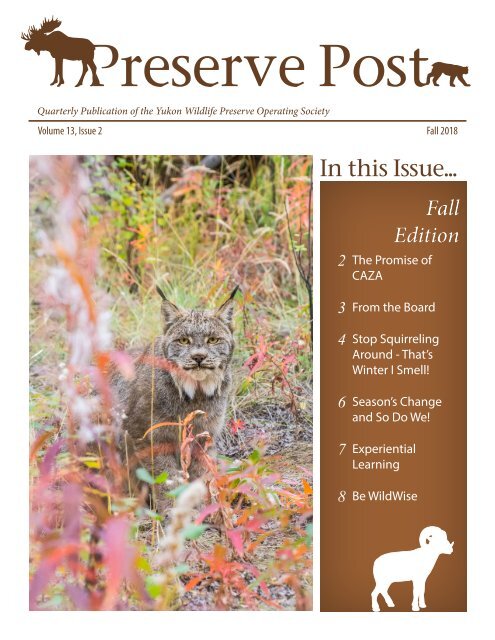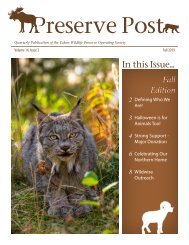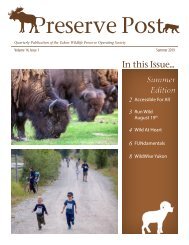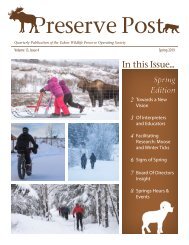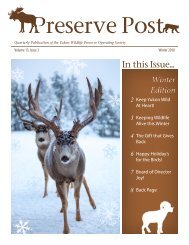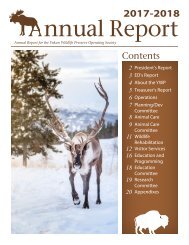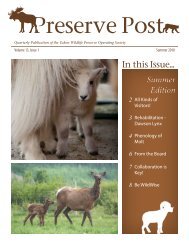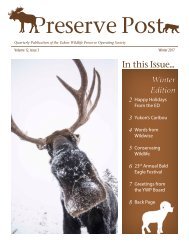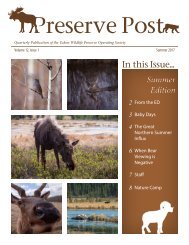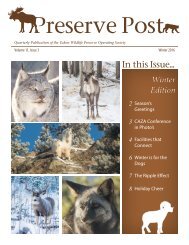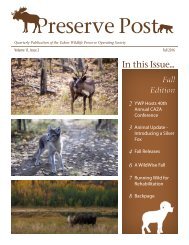2018 FALL Newsletter
Fall is full of change and it's being embraced in so many ways! Check out how the animals, people and landscapes of the north are celebrating the most colourfall time of the year!
Fall is full of change and it's being embraced in so many ways! Check out how the animals, people and landscapes of the north are celebrating the most colourfall time of the year!
Create successful ePaper yourself
Turn your PDF publications into a flip-book with our unique Google optimized e-Paper software.
Quarterly Publication of the Yukon Wildlife Preserve Operating Society<br />
Volume 13, Issue 2<br />
Fall <strong>2018</strong><br />
In this Issue...<br />
2 The Promise of<br />
CAZA<br />
3 From the Board<br />
4 Stop Squirreling<br />
Around - That’s<br />
Winter I Smell!<br />
6 Season’s Change<br />
and So Do We!<br />
7 Experiential<br />
Learning<br />
8 Be WildWise<br />
Fall<br />
Edition
The Promise of CAZA<br />
In mid-September I headed east to attend Canada’s<br />
Accredited Zoos and Aquariums (CAZA) annual<br />
conference. I was there representing the Yukon<br />
Wildlife Preserve - one of Canada’s 29 accredited<br />
institutions.<br />
There are roughly another 170 un-accredited<br />
institutions in Canada. Accreditation is a rigorous<br />
process. The criteria are constantly evolving to reflect<br />
what we know about providing the best care and<br />
welfare possible.<br />
Zoos and aquariums are incredibly diverse places.<br />
Conversation ranged from transparency, activism,<br />
animal care and welfare, research and more. The topics<br />
intersect in surprising ways.<br />
Activists believe that if the public knew what really<br />
happens in zoos (i.e. full transparency), they will come<br />
to see the flaws just as they do. Meanwhile, zoos and<br />
aquariums believe that if the public knew what really<br />
happens in zoos (i.e. full transparency), they would see<br />
the merit and value just as we do.<br />
Much of that conversation and controversy centres<br />
on animal care and welfare. As it should. CAZA’s<br />
members have made a commitment to put it at the<br />
forefront of their organizations. But the issues aren’t<br />
always as well understood.<br />
Even when a zoo can demonstrate their animals eat<br />
better, experience less stress, are healthier, etc., many<br />
still feel that life in the wild is better. The sobering<br />
reality is that “life in the wild” might not always be a<br />
possibility.<br />
In a growing number of cases the world’s most<br />
endangered species survive only within zoological<br />
organizations. The<br />
IUCN Red List<br />
now lists species as<br />
“Extinct in the Wild”.<br />
This acknowledges<br />
the important<br />
role zoological<br />
organizations play in species conservation. (http://bit.<br />
ly/exinwild)<br />
Some animals still have a shot at “life in the wild”<br />
but only because of intensive captive breeding and<br />
release programs run by zoos. Work on blandings<br />
turtles and loggerhead shrikes in Ontario are great<br />
examples that we heard a lot about at this conference.<br />
Experience and research in husbandry and animal<br />
care made those stories possible. Zoo staff know<br />
providing and enhancing welfare is ultimately one of<br />
the most important things we can do - not just for that<br />
individual, but for the species.<br />
In the Yukon, we seem blissfully far away from all this.<br />
But the times, they are a changing.<br />
Sincerely,<br />
Jake Paleczny<br />
Acting Executive Director<br />
Cover photos: Juvenile female lynx in fall colour!<br />
Writing: Lindsay Caskenette, Sidney Campbell, Jake Paleczny,<br />
Julie Kerr, Joe Collier, Emily Hoefs, Briana Van Den Bussche.<br />
Photos and illustrations: Lindsay Caskenette, Jake Paleczny, Joe<br />
Collier, Emily Hoefs, Briana Van Den Bussche.<br />
2<br />
Printed on 100% Recycled Volume Paper 13, Issue 2
From the Board<br />
Like many Yukoners, my visits<br />
to the Preserve are often a family<br />
affair. But when you are a Hoefs,<br />
that takes on a whole new meaning.<br />
My father in law, a young biologist<br />
new to the Yukon in the late 60s,<br />
lived on the property with the<br />
original owners of the “Game<br />
Farm” Danny and Uli Nowlan. We<br />
love to hear stories from that time,<br />
like the one about the mink who<br />
wanted to share his sleeping bag in<br />
the winter, and took to swimming<br />
in the toilet to cool<br />
off.<br />
We have photos of<br />
my husband as a<br />
toddler playing in the elk enclosure.<br />
He eventually had his first job at<br />
the preserve, followed by both of<br />
his brothers, the youngest of whom<br />
still feeds and cares for the animals<br />
during his summers home<br />
from university. One of the<br />
brothers’ responsibilities<br />
in the ‘90s was to watch<br />
over the family pet beaver<br />
“Chippy ClearCut”. Chippy<br />
established the house<br />
bathtub as his habitat,<br />
complete with several feet<br />
of willow branches, until he<br />
was ready to make his way<br />
back into the wild. Times<br />
have certainly changed<br />
between then and what<br />
we experience today at<br />
the successful and well-established<br />
attraction that welcomes thousands<br />
of guests from all over the world<br />
every month.<br />
I’m proud to be a recent addition<br />
to the YWP Board of Directors<br />
so I can help maintain our family<br />
connection to this beloved place<br />
for the next generation of Hoefs,<br />
although we take photos of our son<br />
from the other side of the fence at<br />
the elk enclosure.<br />
Emily Hoefs joined the Yukon Wildlife<br />
Preserve Operating Society’s,<br />
volunteer board of directors at our<br />
<strong>2018</strong> AGM held in July. She brings<br />
with her a connection to the past.<br />
Originally from Nova Scotia she is<br />
an active member of our Yukon<br />
community.<br />
Top Right: Ammon Hoefs stomps around with elk at the Preserve when it was the Nowlan’s property in the<br />
early 1980’s. Bottom Right: Ammon’s son, Hendrik viewing elk on the Preseve today! Bottom Left: Hanne and<br />
Manfred Hoefs with grandson, Hendrik.<br />
Fall <strong>2018</strong><br />
3
Stop Squirreling Around-<br />
That’s Winter I Smell!<br />
Do you feel winter coming? I do.<br />
My garden, like summer itself, has<br />
faded and while I was sad to see it<br />
end, autumn, like it does every year,<br />
eases me gently from one season in<br />
to the next.<br />
As the fireweed blazes crimson and<br />
the first snows dust the mountains,<br />
suddenly, I am eager to prepare<br />
for the coming changes. Tasks I’ve<br />
put off all summer long for “later”<br />
become the priority. I am eager to<br />
split and stack firewood, which is<br />
my signal that “later” is here. In<br />
addition, I am tidying summer<br />
fun away, organizing the shed,<br />
pulling out the mittens, parkas<br />
and blankets. With gladness in<br />
my heart, autumn helps me accept<br />
and adjust to the rhythms of the<br />
seasonal cycle.<br />
Have you noticed that the animals<br />
are doing the same thing we<br />
are? They are preparing for as<br />
comfortable and survivable a winter<br />
as they can. As I split firewood, I<br />
do so to the accompaniment of a<br />
Red Squirrel throwing spruce cones<br />
down from the very top heights<br />
of the tree – I have learned not to<br />
stand directly under any tree with<br />
cones for the gathering, THOCK!<br />
Here at the Preserve, the aspen<br />
leaves dance on the wind, their<br />
colours reminding me of the palette<br />
of the Northern Lights, which have<br />
returned along with our night<br />
skies. Visiting us, you are less<br />
likely than I am to get thocked<br />
by a spruce cone hurled by a<br />
harvesting Red Squirrel; we<br />
are instead seeing the Arctic<br />
Ground Squirrels prepare for<br />
hibernation.<br />
The Arctic Ground Squirrel<br />
is a busy little animal – have<br />
you seen them on one of your<br />
visits here? They choose<br />
to make their home on the<br />
Preserve, enjoying a plentiful<br />
food supply and a lessened risk of<br />
predation. The summer is spent<br />
putting on a layer of fat by eating<br />
as much as they can of the seeds,<br />
leaves, flowers, and berries of a<br />
variety of low-growing plants.<br />
Their home is a burrow and in the<br />
summer the Arctic Ground Squirrel<br />
makes a nest in the den, which is<br />
dug approximately one metre below<br />
ground.<br />
The<br />
materials<br />
used to<br />
make<br />
that<br />
nest will<br />
depend<br />
on what<br />
is available<br />
– lichens,<br />
dried grasses,<br />
or animal hair.<br />
On the Preserve,<br />
this availability<br />
changes based on<br />
which habitat the nest is<br />
in. The squirrels may gather<br />
the hair of elk, caribou, bison or the<br />
quiviut of musk ox, to name a few<br />
options. Have you stopped in our<br />
Reception Cabin and touched the<br />
samples we have of these different<br />
hairs? The next time you are on<br />
the Preserve, have a feel and think<br />
about how soft they each are, or are<br />
not; how would you want your nest<br />
to be lined?<br />
Now that the squirrel is well<br />
fed, fattened up and has a nice<br />
warm home, how does it enter<br />
hibernation? Have you ever stood<br />
waiting for the bus or scraped the<br />
snow off your windshield in the<br />
winter? When the wind is icy, do<br />
you scrunch your entire body up?<br />
Do you try to become smaller to<br />
conserve your energy resources?<br />
The ground squirrel version of this<br />
4<br />
Left: A young ground squirrel, keeping a keen eye out, munches away on grasses<br />
and seeds. Right: Julie Kerr has been an intergral part of the team as a contract<br />
position through the summer. We are all very excited to welcome her in a<br />
permanant position in Visitor Services!<br />
Volume 13, Issue 2
is to roll itself into a<br />
ball by crouching,<br />
tucking its head<br />
down between<br />
its legs, and<br />
tossing its<br />
tail over<br />
its head.<br />
Unlike<br />
you or<br />
I, the<br />
ground<br />
squirrel<br />
is a true<br />
hibernator,<br />
and it<br />
then allows<br />
its body<br />
temperature<br />
to fall to near<br />
zero degrees<br />
Celsius. During the<br />
long northern winter, the squirrel<br />
will periodically warm up to near<br />
its normal temperature, then recool<br />
itself within 24 hours. Arctic<br />
Ground Squirrels can even survive<br />
when their nest drops below<br />
freezing. When my cabin drops<br />
below freezing, I am more doubtful<br />
for my personal survival.<br />
Winter for the ground squirrel<br />
involves hibernation, which can be<br />
as long as eight to ten months every<br />
year. The adults lead hibernation;<br />
first the females head to their dens<br />
as early as late July and by the<br />
middle of September all the adult<br />
females are likely to be hibernating.<br />
They are followed by juvenile<br />
females and lastly by the males –<br />
who stay above ground the longest<br />
but should be hibernating by late<br />
October.<br />
As I say goodbye to the Arctic<br />
Ground Squirrels for the season, I<br />
am happy that I can still have coffee<br />
with my winter compatriot, the Red<br />
Squirrel, since the tree squirrels do<br />
not hibernate, instead remaining<br />
active year round and eating from<br />
the piles of spruce cones they<br />
cached….in my firewood pile as a<br />
matter of fact…..<br />
I am in no rush to end the beautiful<br />
sights, sounds and smells of this<br />
season, but winter is coming and<br />
I am ready. Come take a peek at<br />
the dynamic changes our animals<br />
are undergoing here at the Wildlife<br />
Preserve and experience the<br />
majesty of autumn – see you soon.<br />
Julie is a Registered Veterinary Technologist who has<br />
worked in clinic, in Whitehorse, for the last six years<br />
honing her skills and knowledge on domestic animals.<br />
Her passion is for the wild and it’s with great pleasure<br />
that she is now working to support wild animals from<br />
within the Preserve. She was raised in Saskatchewan<br />
and has a wandering soul but if she has learned<br />
anything in the last six years, it is that the Yukon is the<br />
home of her heart.<br />
Julie is happiest when sharing stories of wild encounters<br />
with the curious of all ages. She has an immense respect<br />
for creatures of all kind, including but not limited to -<br />
wasps, porcupines, foxes and ladybug larva. Stay tuned<br />
- that list changes frequently.<br />
Julie brings her background in tourism and customer<br />
service as the Visitor Services Coordinator, to aid the<br />
smooth running of front of house operations – this helps<br />
everyone focus on the reason we’re all there – the wild<br />
animals under our care.<br />
When to Visit<br />
Fall Hours<br />
OPEN DAILY to October 8 th !<br />
9:30am to 6:00pm - holiday’s included<br />
Guided Bus Tours at 10am, 12noon, 2pm, & 4pm.<br />
October 9 th to December<br />
Open Friday - Sunday 10:30am - 4:00pm<br />
Guided Bus Tours at 12noon, & 2pm.<br />
Walk, run, bike anytime while open.<br />
Enjoy a safe, relaxed environment for the whole<br />
family!<br />
Curious about the latest news? Visit<br />
facebook.com/yukonwildlife or call 456-7300.<br />
We’re Social - join us on Instragram!<br />
Tag us #YukonWildlife<br />
Fall <strong>2018</strong><br />
5
Seasons Change and So Do We!<br />
As autumn arrives and the colors in<br />
the Chilkat Valley begin to change,<br />
the staff at the American Bald Eagle<br />
Foundation are reflecting on the<br />
many changes made here in the<br />
last three years as well as looking<br />
forward to change on the horizon.<br />
In 2015, ABEF made a major<br />
paradigm shift in the way we<br />
train the ambassadors on our<br />
team. Under the direction of<br />
former Raptor Program Manager<br />
Leia Minch, staff embraced a<br />
training approach based on the<br />
most positive, least intrusive<br />
methods available. Using positive<br />
reinforcement and a solid<br />
foundation of behavior science<br />
rather than coercion, the birds<br />
were re-trained to participate in<br />
programs, and now do so willingly<br />
and comfortably. The birds are<br />
empowered to be in control of<br />
their training sessions and the staff<br />
is focused on listening to their<br />
body language<br />
and reacting<br />
accordingly.<br />
As training<br />
changed, so<br />
did standards<br />
of care and<br />
wellness. It was<br />
decided that our<br />
enclosures did<br />
not reflect our<br />
new approach to<br />
empowerment.<br />
Through a pre-development grant<br />
from the Foraker group, ABEF<br />
was able to design new enclosures<br />
which would provide the birds with<br />
more light, enriching views, and<br />
better control of their environment<br />
through access to the elements<br />
and a variety of perches. We’ve<br />
been fundraising for this project<br />
nearly two years, and finally began<br />
to make changes in May with the<br />
demolition of an old, outdated<br />
building. In the coming<br />
weeks, we will begin<br />
phase two- construction<br />
of four brand new aviaries.<br />
Change is something we embrace<br />
here at ABEF. Our understanding<br />
of the natural world is always<br />
changing, and keeping up to date<br />
with best practices, current science,<br />
and educational standards makes<br />
this an ever-changing and exciting<br />
field. We are looking forward to<br />
sharing our new knowledge and<br />
our new facility<br />
with guests as<br />
we continue to<br />
change and grow.<br />
Sidney Campbell is the Education and<br />
Outreach Coordinator at the American Bald<br />
Eagle Foundation in Haines, Alaska. She<br />
works to bring empowering wildlife education<br />
to Haines and surrounding communities<br />
and worldly visitors by managing outreach, publications, and<br />
educational programming. She works with the Raptor Program<br />
Manager to train the avian ambassadors at the facility to take<br />
part in education and outreach. Visit the American Bald Eagle<br />
Foundation in Haines, Alaska. Open Monday to Friday’s 10am<br />
- 2pm. Closed Saturday and Sundays. Explore further online at<br />
https://baldeagles.org/<br />
6<br />
Top Right: Staff look on as Phase I begins with demolition of an old aviary at the<br />
Foundation. Bottom Left: A new weathering yard allows ambassadors like Ole,<br />
the perigrine falcon, to come outside and enjoy the sunshine in front of guests.<br />
Ole and his handler, Sidney have created a very close bond.<br />
Volume 13, Issue 2
Experiential Learning<br />
Even though we’re falling in<br />
love with the autumn colors<br />
here at the Preserve, we want<br />
to take a moment to reflect on<br />
a successful season of summer<br />
Nature Camps! We had a lot of<br />
fun with our<br />
camps which included the<br />
always popular Animal<br />
Care and Wilderness Skills<br />
themes, and some new themes<br />
such as Eco-cycles where<br />
we examined nature’s cycles<br />
happening around us , like the<br />
metaphorasis of rocks, bugs<br />
Fall <strong>2018</strong><br />
and other critters of the Yukon.<br />
We had great opportunities<br />
to see and interact with<br />
animals at the preserve<br />
through activities like animal<br />
feedings, pond dipping and<br />
experiential games. Some of<br />
our camper’s favorite memories<br />
included feeding the arctic<br />
foxes, building bug hotels for<br />
beneficial insects and seeing<br />
“behind the scenes” at the<br />
Preserve. Thanks to great<br />
organizations in the<br />
community such as the<br />
Beringia Centre, The Yukon<br />
Geological Survey, All Paws<br />
Vet Clinic, Mae Bachur<br />
Animal Shelter, Raven<br />
Recycling and Yukon SAR,<br />
campers learnt a lot and<br />
went on some awesome<br />
field trips. Nature camps<br />
and summer may be<br />
over, but youth programs<br />
continue at YWP! We are<br />
busy preparing for our Fall<br />
school programs and are<br />
looking forward to grade 2,<br />
7 and 9 classes coming for<br />
some experiential learning<br />
focused on surviving winter,<br />
Yukon caribou and sexual<br />
reproduction, respectively.<br />
We want to thank everyone<br />
for a great summer of youth<br />
programs and we can’t wait<br />
to discover and explore<br />
again next summer with our<br />
Nature Camps!<br />
Top Right: Campers help cut aspen browse to feed to the animals - an<br />
activity as a part of Animal Care camp! Bottom Left: Campers inspect the<br />
diverse findings from their dip netting adventure!<br />
Full-time Staff<br />
Yukon<br />
Wildlife<br />
Preserve<br />
Jake Paleczny, Acting Executive<br />
Director<br />
Randy Hallock, Director of Outdoor<br />
Operations<br />
Dr. Maria Hallock, Wildlife<br />
Veterinarian and Curator<br />
Lindsay Caskenette, Manager of<br />
Visitor Services<br />
Briana Van Den Bussche, Manager<br />
of Education and Programming<br />
Julie Kerr, Visitor Services<br />
Coordinator<br />
Board of Directors<br />
Alexandra Tait President<br />
Shawna Warshawski, 1 st Vice-<br />
President<br />
Michael Kokiw, 2 nd Vice-President<br />
Kristine Hildebrand, Treasurer<br />
Chris Evans<br />
Tedd Tucker<br />
Harmony Hunter<br />
Emily Hoefs<br />
Meghan Potter<br />
Sherri Young, Non-voting Member -<br />
Environment Yukon<br />
Darrell March, Non-voting Member -<br />
Environment Yukon<br />
7
Above: Visitors take a moment to sit and enjoy the fall view!<br />
Be WildWise!<br />
Fall is here once again and with it<br />
come those wonderful fall routines,<br />
such as berry picking, gathering<br />
firewood, preparing for moose<br />
hunting, or even just picking up a<br />
book that you’ve neglected during<br />
the hectic summer months.<br />
Bears have their own routines<br />
during the fall too. In many cases,<br />
this is the busiest time of the year<br />
for bears, who must enter a state<br />
of ‘hyperphagia,’ which roughly<br />
translates to ‘eating lots’. The dropping<br />
temperatures and reduced sunlight<br />
of the short fall season spur<br />
bears to gain as many calories as<br />
they can before winter so they can<br />
survive the long, dark cold and successfully<br />
reproduce. Did you know<br />
that a bear’s embryo will only<br />
implant and grow if the mother<br />
bear has taken in enough calories<br />
to ensure she will be able to nurse<br />
them through<br />
8<br />
the winter?<br />
Berries (of all kinds) represent<br />
some of the most significant nutrition<br />
for bears, and as trail users and<br />
berry farmers can attest to, plenty<br />
of berries are out in full force now,<br />
including non-native species such<br />
as Saskatoons, chokecherries and<br />
pin cherries on ornamental trees.<br />
Ornamental trees and planted<br />
berry patches can be a tempting<br />
food source for bears and can lead<br />
to trouble. If berries around your<br />
property are ripe, now is the time<br />
to harvest before a bear picks them<br />
first. An abundance of culinary<br />
possibilities awaits. Have you<br />
considered making blueberry wine?<br />
Or perhaps you are in need of some<br />
Thanksgiving cranberry sauce.<br />
And saskatoon berry crumble is a<br />
welcome addition to any potluck or<br />
dinner table!<br />
Lastly, berries around your neighborhood,<br />
even if they are not in<br />
your yard, may attract foraging<br />
bears. Please<br />
encourage your<br />
neighbors to<br />
harvest theirs<br />
and consider organizing a neighborhood<br />
harvest event. Berry picking<br />
with your friends and family is<br />
a great way to spend a fall day!<br />
Joe Collier is a member of Board of<br />
Directors for WildWise Yukon and<br />
a recent graduate of Yukon College.<br />
He enjoys gardening, hiking, camping,<br />
biking and honing his amateur<br />
naturalist skills. He is also an<br />
absolute<br />
music geek<br />
and plays<br />
guitar/<br />
banjo.<br />
Volume 13, Issue 2


